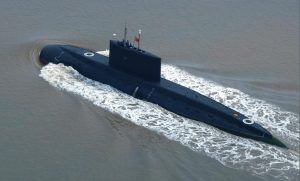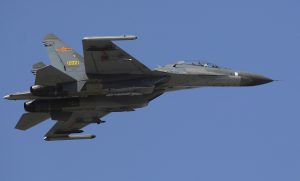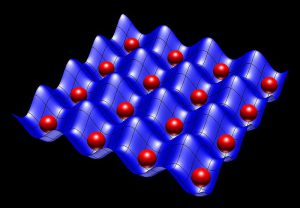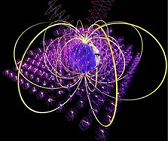[Editor’s Note: In the following guest blog post, Mad Scientist Elsa B. Kania addresses quantum technology and the potential ramifications should the People’s Republic of China (PRC) win the current race in fielding operational quantum capabilities].
 If China were to succeed in realizing the full potential of quantum technology, the Chinese People’s Liberation Army (PLA) might have the capability to offset core pillars of U.S. military power on the future battlefield. Let’s imagine the worst-case (or, for China, best-case) scenarios.
If China were to succeed in realizing the full potential of quantum technology, the Chinese People’s Liberation Army (PLA) might have the capability to offset core pillars of U.S. military power on the future battlefield. Let’s imagine the worst-case (or, for China, best-case) scenarios.
The Chinese military and government could leverage quantum cryptography and communications to enable “perfect security” for its most sensitive information and communications. The PLA may look to employ ‘uncrackable’ quantum key distribution (QKD), which involves the provably secure exchange of keys in quantum states, over fiber optic networks for secure command and control, while extending the range of its quantum networks to more far-flung units or even ships at sea, through an expanding constellation of quantum satellites.
If China were to ‘go dark’ to U.S. intelligence capabilities as a result, then a new level of uncertainty could complicate U.S. calculus and assessments, while exacerbating the risks of surprise or misperception in a crisis or conflict scenario.
China’s massive investments in quantum computing could succeed someday in the decadal marathon towards a fully functional and universal quantum computer.

If developed in secret or operational sooner than expected, then these immense computing capabilities could be unleashed to break public key cryptography. Such asymmetric cryptography, which today is quite prevalent and integral to the security of our information technology ecosystem, relies upon the difficulty of prime factorization, a task beyond the capabilities of today’s classical computers but that could be cracked by a future quantum computer. The impact could be analogous to the advantage that the U.S. achieved through the efforts of American code-breakers ahead of the Battle of Midway.
 Although there will be options available for ‘quantum-proof’ encryption, the use of public key cryptography could remain prevalent in older military and government information systems, such as legacy satellites. Moreover, any data previously collected while encrypted could be rapidly decrypted and exploited, exposing perhaps decades of sensitive information. Will the U.S. military and government take this potential security threat seriously enough to start the transition to quantum-resistant alternatives?
Although there will be options available for ‘quantum-proof’ encryption, the use of public key cryptography could remain prevalent in older military and government information systems, such as legacy satellites. Moreover, any data previously collected while encrypted could be rapidly decrypted and exploited, exposing perhaps decades of sensitive information. Will the U.S. military and government take this potential security threat seriously enough to start the transition to quantum-resistant alternatives?
Future advances in quantum computing could be game changers for intelligence and information processing. In a new era in which data is a critical resource, the ability to process it rapidly is at a premium. In theory, quantum computing could also accelerate the development of artificial intelligence towards a closer approximation to “superintelligence,” provoking concerns of unexpected, by some accounts even existential, risks and powerful capabilities.

Meanwhile, based on active efforts in the Chinese defense industry, the next generation of Chinese submarines could be equipped with a ‘quantum compass’ to enable greater precision in positioning and independence from space-based navigation systems, while perhaps also leveraging quantum communications underwater for secure control and covert coordination.
The PLA might realize its ambitions to develop quantum radar that could be the “nemesis” of U.S. stealth fighters and bolster Chinese missile defense. This “offset” technology could overcome the U.S. military’s advantage in stealth. Similarly, the ‘spooky’ sensitivity in detection enabled by techniques such as ghost imaging and quantum remote sensing could enhance PLA ISR capabilities.
In the aggregate, could China’s future advances in these technologies change the balance of power in the Indo-Pacific?

For China, the potential to disrupt paradigms of information dominance through quantum computing and cryptography, while perhaps undermining U.S. advantages in stealth technologies through quantum radar and sensing, and even more actively contesting the undersea domain, could create a serious challenge to U.S. military-technological predominance.
Perhaps, but this imagining of impactful military applications of quantum technology is far from a reality today. For the time being, these technologies still confront major constraints and limitations in their development.
It seems unlikely that quantum cryptography will ever enable truly perfect security, given the perhaps inevitable human and engineering challenges, along with remaining vulnerabilities to exploitation.
 At present, quantum computing, while approaching the symbolic milestone of “quantum supremacy,” faces a long road ahead, due to challenges of scaling and error correction.
At present, quantum computing, while approaching the symbolic milestone of “quantum supremacy,” faces a long road ahead, due to challenges of scaling and error correction.
Certain quantum devices, for sensing, metrology, and positioning, may be quite useful but could enable fairly incremental, evolutionary improvements relative to the full range of alternatives.
There are also reasons to consider critically when Chinese official media discloses (especially in English) oft-hyped advances such as in quantum radar – since reporting on such apparent progress could be variously intended for purposes of signaling or perhaps even misdirection.

Although China’s advances and ambitions should be taken quite seriously – particularly considering the talent and resources evidently mobilized to advance these objectives – the U.S. military may also be well postured to leverage quantum technology on the future battlefield.
Inevitably, the timeframe for the actual operationalization of these technologies is challenging to evaluate, especially because a significant proportion of the relevant research may be occurring in secret.
For that reason, it is also difficult to determine with confidence whether the U.S. or China is truly leading in the advancement of various disciplines of quantum science.
Moreover, beyond concerns of competition between the U.S. and China, exciting research is occurring worldwide, from Canada and Europe to Australia, often with tech companies and start-ups at the forefront of the development and commercialization of these technologies.
Looking forward, the trajectory of this second quantum revolution will play out over decades to come. Future successes will require sustained investments, such as those China is actively pursuing in the range of tens of billions.
As the Chinese military and defense industry start testing and experimenting with quantum technology, the U.S. military should also explore further the potential – and evaluate the limitations – of these capabilities, including through deepening public-private partnership.
 As China challenges American leadership in innovation, the U.S. military and government should recognize the real risks of future surprises that could result from truly ‘made in China’ innovation, while also taking full advantage of the opportunities to impose surprise upon strategic competitors.
As China challenges American leadership in innovation, the U.S. military and government should recognize the real risks of future surprises that could result from truly ‘made in China’ innovation, while also taking full advantage of the opportunities to impose surprise upon strategic competitors.
The above blog post is based on the recently published Center for a New American Security (CNAS) report entitled Quantum Hegemony? – China’s Ambitions and the Challenges to U.S. Innovation Leadership, co-authored by Ms. Elsa Kania and Mr. John Costello. Mad Scientist believes that this report is the best primer on the current state of quantum technology. Note that quantum science – communication, computing, and sensing – was previously addressed by the Mad Scientist Laboratory as a Pink Flamingo.
Ms. Kania was proclaimed an official Mad Scientist following her presentation on PLA Human-Machine Integration at the Bio Convergence and Soldier 2050 Conference at SRI International, Menlo Park, 8-9 March 2018. Her podcast from this event, China’s Quest for Enhanced Military Technology, is hosted by Modern War Institute.
Disclaimer: The views expressed in this article belong to the author alone and do not represent the Department of Defense, the U.S. Army, or the U.S. Army Training and Training Doctrine Command.
Ms. Kania is an Adjunct Fellow with the Technology and National Security Program at CNAS.



